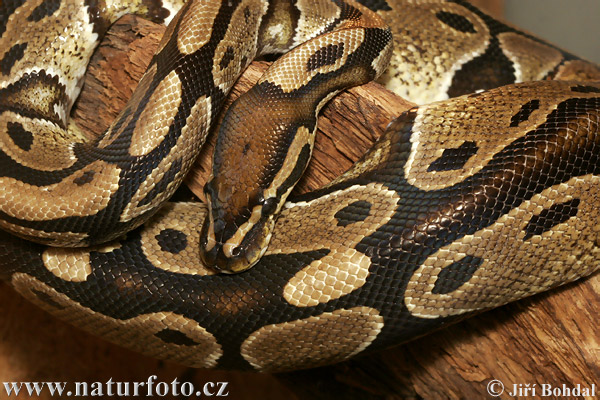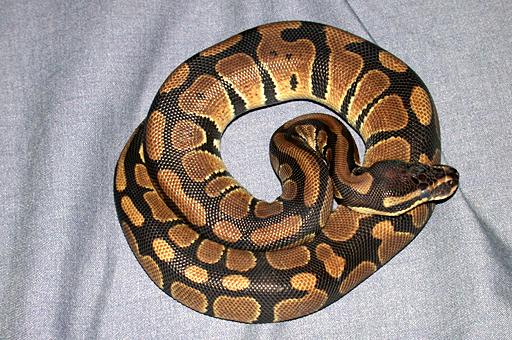Other: Other Related Research
Ball Python
By Chelsea Hunter (05/13/09 17:39:57)
Related animal: Ball Python
Adults generally do not grow to more than 90-120 cm (3-4 feet) in length,[2] although some specimens have reached 152 cm and even 182 cm (5-6 feet), but this is very rare. [4] Females tend to be slightly bigger than males maturing at an average of 4-4.5 feet. Males usually average around 3-3.5 feet. [5]The build is stocky[2] while the head is relatively small. The scales are smooth[4] and both sexes have anal spurs on either side of the vent, although males have larger spurs.[6]
The color pattern is typically black with light brown or gold sides and dorsal blotches. The belly is a white or cream that may or may not include scattered black markings.[4] However, those in the pet industries have, through selective breeding, developed many morphs: genetic mutations with altered colors and patterns.[7]
[edit] Common names
Royal python, ball python.[2]
The name ball python refers to the animal's tendency to curl into a ball when stressed or frightened.[8] The name royal python (from the Latin "regius") is based in part on the story that Cleopatra supposedly wore the snake around her wrist.
[edit] Geographic range
Found in Africa from Senegal, Mali, Guinea-Bissau, Guinea, Sierra Leone, Liberia, Ivory Coast, Ghana, Benin, Niger and Nigeria through Cameroon, Chad and the Central African Republic to Sudan and Uganda. No type locality was given in the original description.[1]
[edit] Habitat
Prefers grasslands, savannahs and sparsely wooded areas.[2]
[edit] Behavior
This terrestrial species is known for its defense strategy that involves coiling into a tight ball when threatened, with its head and neck tucked away in the middle. In this state, it can literally be rolled around. Favored retreats include mammal burrows and other underground hiding places where they also aestivate.[2]
[edit] Feeding
In the wild, the diet consists mostly of small mammals, such as African soft-furred rats, shrews and striped mice. Younger individuals have also been known to feed on birds. Captives usually do well on domestic rats and mice, either live, pre-killed, or frozen-thawed.[4] The size of the prey item should be equivalent to or slightly larger than the width of the largest part of their body. This python is known for being a picky eater and may not eat for months, particularly during the winter breeding season. While this is not odd, care should be taken to watch that the snake does not experience significant weight loss. [9]
[edit] Reproduction
Oviparous, with anywhere from 3-11 rather large eggs being laid (4-6 being most common).[4] These are incubated by the female underground and hatch after 90 days.[2] Sexual maturity is reached at 12-18 months for males, 24-36 months for females. Age is only one factor in determining sexual maturity and ability to breed -- weight is the second factor. Males should be no less than 900g (2.0 lbs.) to breed, and females should be no less than 1500 g (3.3 lbs.).[4]
[edit] Captivity
Due to their smaller size compared to other pythons and commonly docile temperament, these snakes are bred in captivity and have become popular as pets.[10] Juveniles tend to be more aggressive at first, but typically calm down as they get used to human contact. Wild-caught specimens have greater difficulty adapting to a captive environment, which can result in refusal to feed and parasitic infection. Specimens have survived for over 40 years in captivity.[11]
[Write Comment]
By Chelsea Hunter (05/13/09 17:39:57)
Related animal: Ball Python
Adults generally do not grow to more than 90-120 cm (3-4 feet) in length,[2] although some specimens have reached 152 cm and even 182 cm (5-6 feet), but this is very rare. [4] Females tend to be slightly bigger than males maturing at an average of 4-4.5 feet. Males usually average around 3-3.5 feet. [5]The build is stocky[2] while the head is relatively small. The scales are smooth[4] and both sexes have anal spurs on either side of the vent, although males have larger spurs.[6]
The color pattern is typically black with light brown or gold sides and dorsal blotches. The belly is a white or cream that may or may not include scattered black markings.[4] However, those in the pet industries have, through selective breeding, developed many morphs: genetic mutations with altered colors and patterns.[7]
[edit] Common names
Royal python, ball python.[2]
The name ball python refers to the animal's tendency to curl into a ball when stressed or frightened.[8] The name royal python (from the Latin "regius") is based in part on the story that Cleopatra supposedly wore the snake around her wrist.
[edit] Geographic range
Found in Africa from Senegal, Mali, Guinea-Bissau, Guinea, Sierra Leone, Liberia, Ivory Coast, Ghana, Benin, Niger and Nigeria through Cameroon, Chad and the Central African Republic to Sudan and Uganda. No type locality was given in the original description.[1]
[edit] Habitat
Prefers grasslands, savannahs and sparsely wooded areas.[2]
[edit] Behavior
This terrestrial species is known for its defense strategy that involves coiling into a tight ball when threatened, with its head and neck tucked away in the middle. In this state, it can literally be rolled around. Favored retreats include mammal burrows and other underground hiding places where they also aestivate.[2]
[edit] Feeding
In the wild, the diet consists mostly of small mammals, such as African soft-furred rats, shrews and striped mice. Younger individuals have also been known to feed on birds. Captives usually do well on domestic rats and mice, either live, pre-killed, or frozen-thawed.[4] The size of the prey item should be equivalent to or slightly larger than the width of the largest part of their body. This python is known for being a picky eater and may not eat for months, particularly during the winter breeding season. While this is not odd, care should be taken to watch that the snake does not experience significant weight loss. [9]
[edit] Reproduction
Oviparous, with anywhere from 3-11 rather large eggs being laid (4-6 being most common).[4] These are incubated by the female underground and hatch after 90 days.[2] Sexual maturity is reached at 12-18 months for males, 24-36 months for females. Age is only one factor in determining sexual maturity and ability to breed -- weight is the second factor. Males should be no less than 900g (2.0 lbs.) to breed, and females should be no less than 1500 g (3.3 lbs.).[4]
[edit] Captivity
Due to their smaller size compared to other pythons and commonly docile temperament, these snakes are bred in captivity and have become popular as pets.[10] Juveniles tend to be more aggressive at first, but typically calm down as they get used to human contact. Wild-caught specimens have greater difficulty adapting to a captive environment, which can result in refusal to feed and parasitic infection. Specimens have survived for over 40 years in captivity.[11]

|  |